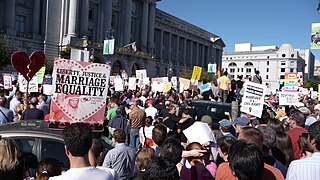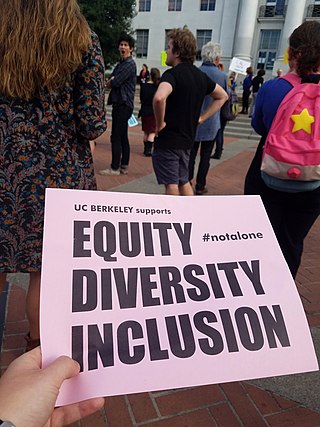
Egalitarianism, or equalitarianism, is a school of thought within political philosophy that builds on the concept of social equality, prioritizing it for all people. Egalitarian doctrines are generally characterized by the idea that all humans are equal in fundamental worth or moral status. As such, all citizens of a state should be accorded equal rights and treatment under the law. Egalitarian doctrines have supported many modern social movements, including the Enlightenment, feminism, civil rights, and international human rights.
Distributive justice concerns the socially just allocation of resources, goods, opportunity in a society. It is concerned with how to allocate resources fairly among members of a society, taking into account factors such as wealth, income, and social status. Often contrasted with just process and formal equal opportunity, distributive justice concentrates on outcomes. This subject has been given considerable attention in philosophy and the social sciences. Theorists have developed widely different conceptions of distributive justice. These have contributed to debates around the arrangement of social, political and economic institutions to promote the just distribution of benefits and burdens within a society. Most contemporary theories of distributive justice rest on the precondition of material scarcity. From that precondition arises the need for principles to resolve competing interest and claims concerning a just or at least morally preferable distribution of scarce resources.

Equality of outcome, equality of condition, or equality of results is a political concept which is central to some political ideologies and is used in some political discourse, often in contrast to the term equality of opportunity. It describes a state in which all people have approximately the same material wealth and income, or in which the general economic conditions of everyone's lives are alike.
Equal opportunity is a state of fairness in which individuals are treated similarly, unhampered by artificial barriers, prejudices, or preferences, except when particular distinctions can be explicitly justified. For example, the intent of equal employment opportunity is that the important jobs in an organization should go to the people who are most qualified – persons most likely to perform ably in a given task – and not go to persons for reasons deemed arbitrary or irrelevant, such as circumstances of birth, upbringing, having well-connected relatives or friends, religion, sex, ethnicity, race, caste, or involuntary personal attributes such as disability, age. According to proponents of the concept, chances for advancement should be open to everybody without regard for wealth, status, or membership in a privileged group. The idea is to remove arbitrariness from the selection process and base it on some "pre-agreed basis of fairness, with the assessment process being related to the type of position" and emphasizing procedural and legal means. Individuals should succeed or fail based on their efforts and not extraneous circumstances such as having well-connected parents. It is opposed to nepotism and plays a role in whether a social structure is seen as legitimate. The concept is applicable in areas of public life in which benefits are earned and received such as employment and education, although it can apply to many other areas as well. Equal opportunity is central to the concept of meritocracy. There are two major types of equality:

Pedagogy, most commonly understood as the approach to teaching, is the theory and practice of learning, and how this process influences, and is influenced by, the social, political, and psychological development of learners. Pedagogy, taken as an academic discipline, is the study of how knowledge and skills are imparted in an educational context, and it considers the interactions that take place during learning. Both the theory and practice of pedagogy vary greatly as they reflect different social, political, and cultural contexts.
Lawrence Kohlberg's stages of moral development constitute an adaptation of a psychological theory originally conceived by the Swiss psychologist Jean Piaget. Kohlberg began work on this topic as a psychology graduate student at the University of Chicago in 1958 and expanded upon the theory throughout his life.
Equity, or economic equality, is the construct, concept or idea of fairness in economics and justice in the distribution of wealth, resources, and taxation within a society. Equity is closely tied to taxation policies, welfare economics, and the discussions of public finance, influencing how resources are allocated among different segments of the population.
Critical consciousness, conscientization, or conscientização in Portuguese, is a popular education and social concept developed by Brazilian pedagogue and educational theorist Paulo Freire, grounded in neo-Marxist critical theory. Critical consciousness focuses on achieving an in-depth understanding of the world, allowing for the perception and exposure of social and political contradictions. Critical consciousness also includes taking action against the oppressive elements in one's life that are illuminated by that understanding.
Solidarity economy or Social and Solidarity Economy (SSE) refers to a wide range of economic activities that aim to prioritize social profitability instead of purely financial profits. A key feature that distinguishes solidarity economy entities from private and public enterprises is the participatory and democratic nature of governance in decision-making processes as one of the main principles of the SSE sector. Active participation of all people involved in decision-making procedures contributes to their empowerment as active political subjects. However, different SSE organizational structures reflect variations in democratic governance and inclusive participation. Ultimately, SSE represents a crucial tool in guaranteeing that social justice ideals are upheld and that the wellbeing of the most vulnerable populations is paid attention to during the planning processes.
Multicultural education is a set of educational strategies developed to provide students with knowledge about the histories, cultures, and contributions of diverse groups. It draws on insights from multiple fields, including ethnic studies and women studies, and reinterprets content from related academic disciplines. It is a way of teaching that promotes the principles of inclusion, diversity, democracy, skill acquisition, inquiry, critical thought, multiple perspectives, and self-reflection. One study found these strategies to be effective in promoting educational achievements among immigrant students.

Social equity is concerned with justice and fairness of social policy. Since the 1960s, the concept of social equity has been used in a variety of institutional contexts, including education and public administration.
Although the noun forms of the three words aim, objective and goal are often used synonymously, professionals in organised education define the educational aims and objectives more narrowly and consider them to be distinct from each other: aims are concerned with purpose whereas objectives are concerned with achievement.
Educational equity, also known as equity in education, is a measure of equity in education.

Social equality is a state of affairs in which all individuals within society have equal rights, liberties, and status, possibly including civil rights, freedom of expression, autonomy, and equal access to certain public goods and social services.
Social justice art, and arts for social justice, encompasses a wide range of visual and performing art that aim to raise critical consciousness, build community, and motivate individuals to promote social change. Art has been used as a means to record history, shape culture, cultivate imagination, and harness individual and social transformation. It can not only be a means to generate awareness, but it can also be a catalyst to engage community members to take action around a social issue.
Social justice educational leadership emphasizes the belief that all students can and will reach proficiency, without exceptions or excuses, and that schools ought to be organized to advance the equitable learning of all students. Rather than focusing on one group of students who traditionally struggle, or who traditionally succeed, social justice leaders address the learning needs of all students. Social justice educational leadership specifically addresses how differences in race, income, language, ability, gender, and sexual orientation influence the design and effectiveness of learning environments. Social justice leadership draws from inclusive education practices from disability education, but extends the concepts further to support students from diverse groups with a wide range of needs. Through restructuring staff allocation and assessing student progress through disaggregated data, school leaders strive to create schools with equal access and equitable support for all students.
Critical mathematics pedagogy is an approach to mathematics education that includes a practical and philosophical commitment to liberation. Approaches that involve critical mathematics pedagogy give special attention to the social, political, cultural and economic contexts of oppression, as they can be understood through mathematics. They also analyze the role that mathematics plays in producing and maintaining potentially oppressive social, political, cultural or economic structures. Finally, critical mathematics pedagogy demands that critique is connected to action promoting more just and equitable social, political or economic reform.

Critical Pedagogy Primer is a book by Joe L. Kincheloe published by Peter Lang. Like other "primers" published by Peter Lang, it is an introductory text on the topic of critical pedagogy aimed at a wider audience with its use of more accessible language. The book has wide margins suitable for reader annotations, and many terms and their definitions are included in these margins for accessibility.
Equity and inclusion in education refers to the principle or policy that provides equal access for all learners to curriculum and programming within an educational setting. Some school boards have policies that include the terms inclusion and diversity. Equity is a term sometimes confused with equality. Equity and inclusion policy provide a framework for educators and academic administrators that guides training and delivery of instruction and programming. School boards use equity and inclusion principles to promote the use of resources that reflect the diversity of students and their needs.

Diversity, equity, and inclusion (DEI) are organizational frameworks which seek to promote the fair treatment and full participation of all people, particularly groups who have historically been underrepresented or subject to discrimination on the basis of identity or disability. These three notions together represent "three closely linked values" which organizations seek to institutionalize through DEI frameworks. Some experts say diversity and inclusion should be decoupled in some cases. Some frameworks, primarily in Britain, substitute the notion of "equity" with equality: equality, diversity, inclusion (EDI). Other variations include diversity, equity, inclusion and belonging (DEIB), justice, equity, diversity and inclusion, or diversity, equity, inclusion and access.






